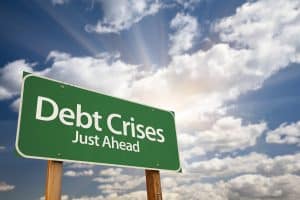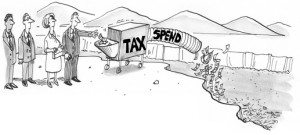Several months ago this post began as research for what I hope will be a fifth novel. The action in that story will take place in the near future, when the negative effects of a National Debt “death spiral” begin to impact everyday families and businesses. I wish the following were also fiction, but unfortunately it will be quite real.
“The current levels of National Debt and of Budget Deficits are unsustainable.”
We read that sentence a lot, but what does it actually mean?
 This may be the most important economic policy subject I’ve ever written about, because the precise consequences of not fixing this problem are largely unpredictable, but the experts all agree that the consequences will be terrible, and that whatever form they take, they pose a real existential threat to every aspect of our lives.
This may be the most important economic policy subject I’ve ever written about, because the precise consequences of not fixing this problem are largely unpredictable, but the experts all agree that the consequences will be terrible, and that whatever form they take, they pose a real existential threat to every aspect of our lives.
We are in uncharted waters. The experts sense from the water backing up that there must be a waterfall ahead, but they’re not sure how far off it really is. Around the next bend? Or still some time off? No one is certain. But they are certain that, despite today’s seemingly calm waters, the precipice is rapidly approaching, and we must turn back, or suffer painful consequences that will take years, if ever, to heal and correct.
What is the problem? The ever-rising National Debt and the current Budget Deficits that are adding to that debt every day.
Before examining the problem itself and a possible cure, let’s take a look at some of the consequences of not fixing the problem soon. Experts predict that most of these negative impacts will occur long before we actually go over the waterfall into default itself.
- Increased Debt Servicing Costs. As foreign and domestic investors look at our economy, our level of debt, and our inflation, they will demand a higher return on our debt in order to keep buying it from the government. These higher rates will then lead to still higher total borrowing costs, adding more to the deficit, creating a potential death spiral of ever-increasing debt and ever-increasing borrowing costs.

- As the government requires more and more funds to service its debt, it will crowd out investment which otherwise would go into private business, reducing the amount of capital spent on new equipment and technology, thereby reducing overall productivity—just the opposite of what is needed to pay the increased debt burden.
- Higher interest rates causing reduced private investment and less consumption will lead to economic slowdown and recession. There will be more unemployment, creating more benefit payments, and lower tax revenue. These will exacerbate the deficit death spiral.
- The government will have no flexibility to respond to a real crisis—either an enemy’s attack or an economic downturn. Interest on the Debt today is already almost equal to our total Defense spending. As the interest portion grows, important Defense projects will have to be cut, leaving us vulnerable. The same will happen with social entitlements. And the usual measures to reverse an economic crisis—cutting taxes and spending more—will only increase the crisis.
- With higher interest rates impacting both corporate and personal borrowing costs, the stock market and the housing market will suffer unpleasant and unwanted downturns in values.
- There will be a reduction in Public Services and Social Programs. These will happen on an emergency basis, unplanned, and so will likely be very painful. Will the social fabric of our nation hold up under that kind of stress, when each Identity Group looks to blame someone for their victimhood?
- The most likely response, if we actually go over the side, is much increased printing of money and very high inflation for several years, eventually reducing the real cost of monetary debt, and decreasing the value of US financial assets, though probably also increasing the value of real assets. Jobs will be lost and jobs will be created. The dollar will fall in value, and imports of all types will be much more expensive. International trade will be disrupted and re-routed based on new exchange rates. If we can hold our nation together through all those changes and all that expected blame, the final result could in the end be positive. But the pain and disruption required to get there would be enormous, and would require exceptional leadership.
Those are just some of the probable consequences of not fixing this problem now, of not turning around before we get so close to the waterfall that we’re not even able to save ourselves.
 Notice that these consequences dwarf the usual topics for economic policy debate. We’re talking about impacting all investments, all consumption, all international trade. Many lost jobs. Years of lost growth. Major disruptions to whole industries and most institutions. Winners and losers.
Notice that these consequences dwarf the usual topics for economic policy debate. We’re talking about impacting all investments, all consumption, all international trade. Many lost jobs. Years of lost growth. Major disruptions to whole industries and most institutions. Winners and losers.
Relevant questions are: Why has this become such an issue now, and Hasn’t it been around for years?
Yes and no. Yes, debt and deficits have been around for years, and are the work of both political parties, and of many Administrations. Because no one in either party has had the political will to fix the problem while in power, it has continued, growing worse and worse.
The difference today is simply the huge level of debt and deficits, which materially impact our ability to manage them. As Luke Groman points out in his interview on the Back To The People podcast, instead of a deficit being a tool to help fix an economic problem, the deficit is the problem.
Economists generally look at the ratio of US Debt Held by the Public to Gross National Product as the key indicator of our debt’s power over us.
At the end of 2023 the amount of debt held by the public was about $26.5 trillion, while total sovereign debt was about $34 trillion. The difference is debt held between different government agencies. And note that neither figure includes the “off balance sheet” debt owed to future retirees, primarily for Social Security and Medicare. The government projects that those unfunded liabilities amount to an additional $78 trillion (02-15-2024-FR-(Final).pdf (treasury.gov), page 192).
But using the smallest relevant measure, the US Debt Held by the Public, today that amount represents 96.5% of total Gross National Product. In 1980 it was only 26%, meaning that we could cut taxes and spend more to stimulate the economy, thereby increasing the ratio to 42% ten years later, but also unleashing an increase in productivity and growth which then reduced the ratio back to 35% in 2000.
Today, at nearly 100%, we can’t cut taxes. But we are certainly spending. It is almost unbelievable that with only 3.5% unemployment we are still running a huge deficit to fund current operations, saddling future generations with the cost of our bloated diet for everything the federal government has promised us. Not to mention the other $78 trillion we’ve promised in the future but don’t talk about.
running a huge deficit to fund current operations, saddling future generations with the cost of our bloated diet for everything the federal government has promised us. Not to mention the other $78 trillion we’ve promised in the future but don’t talk about.
How much longer can we do this? When does the death spiral of ever-increasing deficit costs drive us over the edge, either to default or to rampant inflation and disruption?
No one really knows. But last October The University of Pennsylvania Wharton School published a Budget Model with the following conclusions:
“We estimate that the US debt held by the public cannot exceed 200% of GDP, even under today’s generally favorable market conditions…Under current policy, the US has about 20 years for corrective action, after which no amount of future tax increases or spending cuts could avoid the government defaulting on its debt whether explicitly or implicitly (i.e., debt monetization producing significant inflation)…This time frame is the ‘best case’ scenario, under market conditions where participants believe that corrective fiscal actions will happen ahead of time. If, instead, they started to believe otherwise, debt dynamics would make the time window for corrective action even shorter.”
The solution is not fancy nor complicated. We must spend less.
Implementing the solution may be a little complicated, but mainly it will take honest leadership and unwavering resolve to do the right thing, no matter who complains or from where: Wall Street, Main Street, Rural America, the Inner City, Universities, or, in particular, inside the Beltway in D.C.
And note that the correction of less spending must start now, after this next election, no matter who wins, because if market expectations tip over to believe that there is no correction coming, as the Wharton Model notes, then we could be at the edge of the waterfall almost overnight.
 Is either Presidential candidate, or either major party, prepared to tell the American people the truth about what must happen to government spending? Particularly the part that winds up in each voter’s individual wallet?
Is either Presidential candidate, or either major party, prepared to tell the American people the truth about what must happen to government spending? Particularly the part that winds up in each voter’s individual wallet?
That’s where we need some creativity and clear thinking to appeal to the American sense of fairness, if there is to be any hope of actually choking the federal spending beast.
There are presumably several ways to implement spending less at the federal level, and I I’m open to any process that will work. Over the years I’ve made some proposals in these pages for how to do so fairly.
1. Next year, and each year thereafter, all managers in all government departments at all levels will have to make do with three percent less funds. And the next year three percent less. And the next. For at least five years and fifteen percent, while the economy grows and the terrible Debt to GDP Ratio starts to reduce.
Managers are supposed to be skilled and intelligent. We pay them to manage. So they should do so, and figure out how to do what really has to be done with less funds. Not one size will fit all. Perhaps cut back some unnecessary programs (petition Congress if authority is needed to do so), or let some people go, reduce bonuses, reduce overhead. We don’t need to tell them—they can figure out how best to slightly downsize their budgets.
And what is the reduction to be based on: this year’s budget, or actual expenditures to date? Next year’s reduction should be calculated from this year’s budget, and if all of the funds have not been spent this year, the manager can keep those funds and use them next year. No reason to rush to spend before year end, as usually happens. Better to encourage thrift and good stewardship.
2. Every person and company who receives any direct subsidies from the Government (Social Security, Farm Subsidies, Ethanol, Corporate Tax Credits, Childcare, Food Stamps, etc.) will receive three percent less next year. And on for five more years to a total of fifteen percent less five years from now. We will all share in the process of reducing the bloated spending that we have helped create. And we’ll have time to make choices of how to implement this small reduction in our own personal and corporate lives. The sum of all these small reductions will be big numbers, while providing five years during which to adjust.
Tax Credits, Childcare, Food Stamps, etc.) will receive three percent less next year. And on for five more years to a total of fifteen percent less five years from now. We will all share in the process of reducing the bloated spending that we have helped create. And we’ll have time to make choices of how to implement this small reduction in our own personal and corporate lives. The sum of all these small reductions will be big numbers, while providing five years during which to adjust.
We’ve proven that no official will vote to kill his or her local subsidies. But everyone should be able to vote for an across-the-board reduction, shared by every citizen and every business. Everyone.
Going further, we should look into closing whole unnecessary departments—Education—and entire ineffective programs—The War on Drugs. We should also address the future unfunded $78 trillion commitment to later generations by making some small changes in the contractual details, like delaying Social Security payments for a year or two for those who are now forty or younger. And with less pressure to raise more taxes, maybe we can also reform the tax system. But that may be asking too much. The place to start immediately is just to cut back on spending.
How hard will that be to do? The concept is logical, evenly implemented across all ideological programs, and verifiable. Personally I would exempt the military—only a small part of the budget anyway—but to pass this program I would hope that the military could also figure out how to conform.
 Our leaders will have to say, mean and explain to all of us: To have more for all of us in five years, and to ensure that the same will be true for our children and grandchildren for the long term, we have to spend and receive a little less each year now.
Our leaders will have to say, mean and explain to all of us: To have more for all of us in five years, and to ensure that the same will be true for our children and grandchildren for the long term, we have to spend and receive a little less each year now.
One immediate effect of this program will be to assure investors that, in fact, we are addressing the problem, helping to push the potential for default further into the future, giving us more time for the solutions to make a real difference, if we only have the courage to implement them.
Besides supporting candidates who exhibit the understanding and the courage to tackle this problem in November, what should individuals do to prepare for any of the negative impacts noted above? Almost ten years ago I wrote a post entitled “Preparing for the Next Black Swans.”, which is also Essay #23 (page 103) in Seeking Truth at the Intersection of Faith, Economics and Policy. Those recommendations are still very relevant today. The one that has always stood out to me is that we must intentionally Build Margin into our lives: financial, relational, time. Margin gives us the flexibility to better absorb shocks, whatever they are, without breaking.
And of course Faith. I know that God is not wringing His hands about what to do about this problem. Whatever my perspective, God is always in control, and events will work out for His purposes in history. If we are followers of His son, He doesn’t promise that we will never have trials or problems while journeying here, but that He will be with us on the road. And He reminds us that even the long term here is but the blink of an eye compared to eternity. So Faith helps keep even the most difficult issues in perspective.
That said, while journeying here we are commanded to use the gifts and talents He’s given us to improve the lives of others. So let’s roll up our sleeves, understand the seriousness of the debt threat to our nation and to our families, and then work to implement policies and to elect candidates who will actually address reducing federal spending levels, right now.
Personal Notes: If you’ve enjoyed these subjects over the years, both novels and posts, please tell others about this new Substack format. Send your friends this link.
And of course please also tell others about the six books on our website: Christian Fiction Books (parkerhudson.com).
As always, thank you!
Resources:
- This Time Is Different: Eight Centuries of Financial Folly.. Carmen Reinhart and Kenneth Rogoff. This Time Is Different: Eight Centuries of Financial Folly: Reinhart, Carmen M., Rogoff, Kenneth S.: 8601404555053: Amazon.com: Books
- “When Does Federal Debt Reach Unsustainable Levels?” The Penn Wharton Budget Model. When Does Federal Debt Reach Unsustainable Levels? — Penn Wharton Budget Model (upenn.edu).
- Luke Groman’s insightful Tree Rings Reports https://bit.ly/4bTBzMX. The newsletter requires a monthly subscription, but as an introduction, you can listen to an excellent free interview with Luke on The Back To The People podcast. https://apple.co/4bRZFYp.
- “Financial Report of the United States Government, 2023.” 02-15-2024-FR-(Final).pdf (treasury.gov).
- “The Nation’s Fiscal Health.” US Government Accountability Office. gao-23-106201.pdf.
- Seeking Truth at the Intersection of Faith, Economics and Policy.


I only have one or two problems with your article. Otherwise it is spot on. I take some exception to reducing social security since it was supposed to be an insurance plan to provide income in our old age and funded by employees and employers. Not funded by income taxes. You failed to address federal retirement. It seems no one ever does address that. Could that not be gradually changed to something like a 401 as the private sector has done for the most part.? Home prices have escalated partly because rent prices have escalated due to government involvement. I see this all the time. I saw a picture of a house for rent under the HUD program and realized it was up the road from our home. The rent was double what that house should have been. Also, the program paying the owner several hundred dollars a month more if rented to a minority. These government programs have hurt the working poor and even the middle class so that others can live in homes they cannot afford. I know of a couple who rented a modest but neat and in good condition house in a modest neighborhood. They divorced, so the wife then got HUD housing in a nicer neighborhood and house. Why? Later she had either her former husband or a boyfriend living with her. We see that happen every day. Address this type of government insertions in our lives rather than always targeting social security.